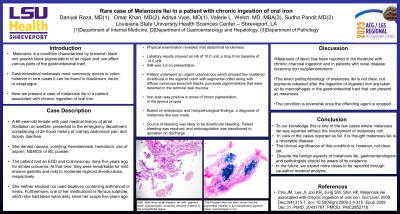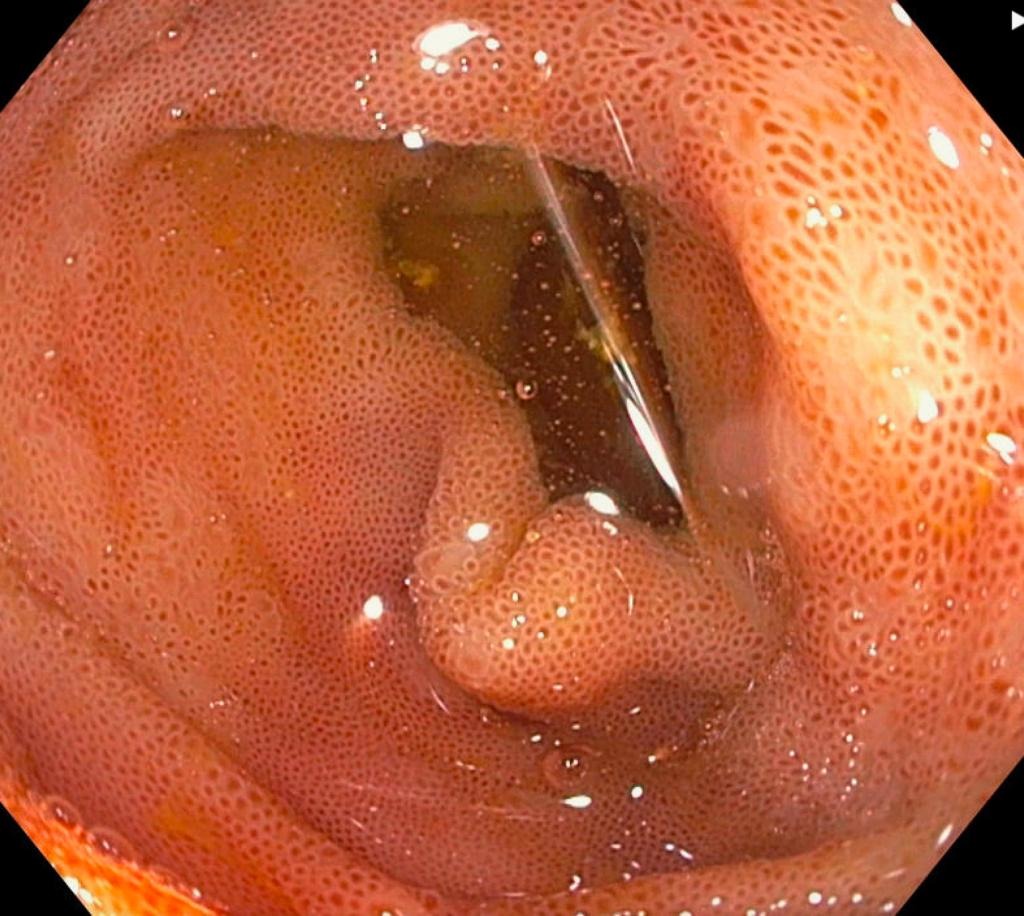Tuesday Poster Session
Category: Small Intestine
P4120 - Rare Case of Melanosis Ilei Associated With Chronic Ingestion of Oral Iron
Tuesday, October 24, 2023
10:30 AM - 4:00 PM PT
Location: Exhibit Hall

Has Audio
.jpeg.jpg)
Daniyal Raza, MD
LSU Health Sciences Center
Shreveport, LA
Presenting Author(s)
Daniyal Raza, MD, Omar Khan, MD, Aditya Vyas, MD, Valerie Lockhart Welch, MD, Sudha Pandit, MD
LSU Health Sciences Center, Shreveport, LA
Introduction: Melanosis is a rare condition characterized by abnormal pigmentation in an organ. However, in this case, we present an instance of melanosis ilei, which involves pigmentation changes in the ileum of the gastrointestinal tract. The patient developed melanosis ilei as a result of chronic oral iron ingestion. This case highlights the importance of considering melanosis as a potential diagnosis when encountering unusual pigmentation changes in the gastrointestinal tract, and understanding the underlying causes can guide appropriate management and treatment decisions.
Case Description/Methods: 66-year-old female with a history of atrial fibrillation on warfarin presented to the with concerns of abdominal pain and bloody diarrhea for the past one day. She denied experiencing nausea, vomiting or hematemesis . Patient had undergone an esophagogastroduodenoscopy (EGD) and colonoscopy 5 years ago, which revealed gastritis and sigmoid diverticulosis, respectively. She did not smoke or use laxatives containing anthracoid or herbs. She had also taken ferrous sulfate twice daily since her previous scope. Physical examination showed mild abdominal tenderness.
Labs were remarkable for a drop in hemoglobin of 4 units and INR of 3.9 on presentation. An urgent colonoscopy was performed, revealing a few diverticula in the sigmoid colon with segmental colitis. Additionally, numerous diffuse brownish-black punctuate pigmentations were detected in the terminal ileum. Iron stain testing confirmed brown pigmentation in the lamina propria, leading to a diagnosis of melanosis ilei based on EGD and histopathological findings. Source of bleeding was likely due to diverticulae. Patient's bleeding resolved, and anticoagulation was transitioned to apixaban upon discharge.
Discussion: Melanosis ilei has been documented in the literature in cases of chronic charcoal ingestion and in patients with renal disease who receive iron supplements. The precise underlying mechanism of melanosis ilei remains uncertain; however, it is believed that pigments released during the digestion of ingested iron are absorbed by macrophages in the gastrointestinal tract, leading to the manifestation of melanosis. The condition is reversible upon discontinuation of the causative agent. This case represents a unique instance of melanosis ilei reported without the presence of melanosis coli. Melanosis ilei is a reversible condition with unclear clinical significance, but awareness among gastroenterologists and pathologists is important.

Disclosures:
Daniyal Raza, MD, Omar Khan, MD, Aditya Vyas, MD, Valerie Lockhart Welch, MD, Sudha Pandit, MD. P4120 - Rare Case of Melanosis Ilei Associated With Chronic Ingestion of Oral Iron, ACG 2023 Annual Scientific Meeting Abstracts. Vancouver, BC, Canada: American College of Gastroenterology.
LSU Health Sciences Center, Shreveport, LA
Introduction: Melanosis is a rare condition characterized by abnormal pigmentation in an organ. However, in this case, we present an instance of melanosis ilei, which involves pigmentation changes in the ileum of the gastrointestinal tract. The patient developed melanosis ilei as a result of chronic oral iron ingestion. This case highlights the importance of considering melanosis as a potential diagnosis when encountering unusual pigmentation changes in the gastrointestinal tract, and understanding the underlying causes can guide appropriate management and treatment decisions.
Case Description/Methods: 66-year-old female with a history of atrial fibrillation on warfarin presented to the with concerns of abdominal pain and bloody diarrhea for the past one day. She denied experiencing nausea, vomiting or hematemesis . Patient had undergone an esophagogastroduodenoscopy (EGD) and colonoscopy 5 years ago, which revealed gastritis and sigmoid diverticulosis, respectively. She did not smoke or use laxatives containing anthracoid or herbs. She had also taken ferrous sulfate twice daily since her previous scope. Physical examination showed mild abdominal tenderness.
Labs were remarkable for a drop in hemoglobin of 4 units and INR of 3.9 on presentation. An urgent colonoscopy was performed, revealing a few diverticula in the sigmoid colon with segmental colitis. Additionally, numerous diffuse brownish-black punctuate pigmentations were detected in the terminal ileum. Iron stain testing confirmed brown pigmentation in the lamina propria, leading to a diagnosis of melanosis ilei based on EGD and histopathological findings. Source of bleeding was likely due to diverticulae. Patient's bleeding resolved, and anticoagulation was transitioned to apixaban upon discharge.
Discussion: Melanosis ilei has been documented in the literature in cases of chronic charcoal ingestion and in patients with renal disease who receive iron supplements. The precise underlying mechanism of melanosis ilei remains uncertain; however, it is believed that pigments released during the digestion of ingested iron are absorbed by macrophages in the gastrointestinal tract, leading to the manifestation of melanosis. The condition is reversible upon discontinuation of the causative agent. This case represents a unique instance of melanosis ilei reported without the presence of melanosis coli. Melanosis ilei is a reversible condition with unclear clinical significance, but awareness among gastroenterologists and pathologists is important.

Figure: EGD showing melanosis ilei.
Disclosures:
Daniyal Raza indicated no relevant financial relationships.
Omar Khan indicated no relevant financial relationships.
Aditya Vyas indicated no relevant financial relationships.
Valerie Lockhart Welch indicated no relevant financial relationships.
Sudha Pandit indicated no relevant financial relationships.
Daniyal Raza, MD, Omar Khan, MD, Aditya Vyas, MD, Valerie Lockhart Welch, MD, Sudha Pandit, MD. P4120 - Rare Case of Melanosis Ilei Associated With Chronic Ingestion of Oral Iron, ACG 2023 Annual Scientific Meeting Abstracts. Vancouver, BC, Canada: American College of Gastroenterology.
